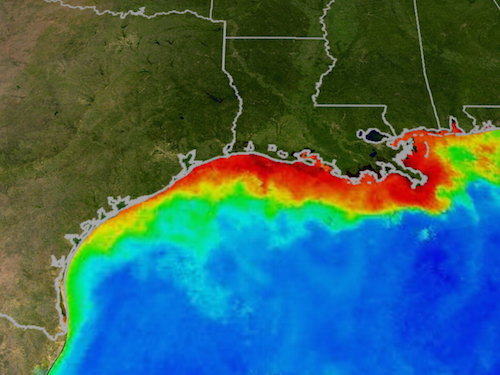Is it possible for bad news to also be good news? It depends on the subject, really. In the case of environmental destruction, however, finding out that things won’t be as bad as usual is sadly considered “good news” at this point.
Earlier this week, researchers from the University of Michigan and several other institutions released a report showing that the dead zone in the Gulf of Mexico will be back down to “average size” this year, after several years of being “above average” in size.
From the University of Michigan release:
For the second year in a row, the Gulf of Mexico hypoxia forecast was based on the predictions of four computer models, with individual forecasts ranging from 5,204 to 6,823 square miles. Forecasts based on multiple models are called ensemble forecasts; the technique is commonly used to forecast hurricanes and other weather events.
The models were developed by NOAA-sponsored teams and researchers at the University of Michigan, Louisiana State University, the Louisiana Universities Marine Consortium, the Virginia Institute of Marine Sciences/College of William and Mary, Texas A&M University, North Carolina State University and the U.S. Geological Survey.
The dead zone is created by freshwater runoff containing various oxygen-destroying minerals and chemicals, particularly those used in fertilizers. These chemicals travel along rivers, streams, and rainwater from all over the country and flow into the Gulf of Mexico and other bodies of water where they make it difficult for marine life to flourish. The chemicals promote the growth of algae that siphons oxygen away from marine fauna.
And even though the dead zone is expected to remain “average” this year, it will still be roughly the size of the state of Connecticut, which will still produce a devastating effect on the economy of the Gulf Coast.
For example, the Gulf Coast supplies about 40% of the nation’s seafood. Since the area of the dead zone is located close to shore, this will mean that the most abundant sources of seafood will see a lower-than-average yield, and fishermen will be forced to move further out into territory where it becomes more difficult and expensive to fish, raising seafood prices and depressing total sales.
These economic downturns will have a ripple effect throughout coastal communities, where commercial fishers will reduce spending at local establishments, thereby reducing the income of those purveyors and so on.
We’re already beginning to see the effects on marine life in coastal communities. Pensacola, Florida is experiencing a shortage of sharks that has been directly linked to the Gulf dead zone.
The absence of large predators suggests that oxygen levels have fallen to the point where larger animals are no longer able to thrive in these waters, and if this trend continues, the remaining animals will soon find the conditions in coastal communities unfavorable and move in search of oxygen-rich waters.
As we’ve seen from the Deepwater Horizon oil spill in 2010, the economic and environmental impacts of the Gulf of Mexico can be felt throughout the country. And while this year’s dead zone might be back to “average” size, the years of having larger than average dead zones are already taking their toll on the animals and people who call the Gulf Coast home.
Image source – Science Education Resource Center
Subscribe to our newsletter
Stay up to date with DeSmog news and alerts






